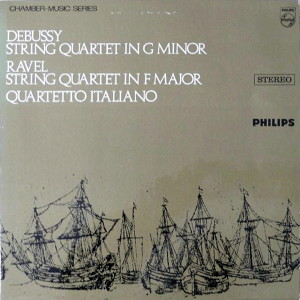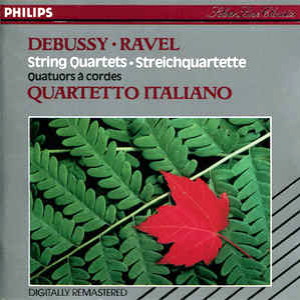 |
|
Philips
- 1 LP - 835 361 - (p) 1967
|
 |
| Philips
- 1 CD - 420 894-2 - (c) 1988 |
|
| Claude Debussy
(1862-1918) |
|
|
|
|
|
|
|
String
Quartet in G minor, Op. 10
|
|
26' 34" |
|
| -
Animé et très décidé |
6' 23" |
|
|
| -
Scherzo (Assez vif et bien rhythmé) |
3' 55" |
|
|
| -
Andantino, doucement expressif |
8' 36" |
|
|
-
Très modéré - Très mouvementé et
avec passion - Très animé - Très vif
|
7' 40" |
|
|
|
|
|
|
| Maurice Ravel
(1875-1937) |
|
|
|
|
|
|
|
| String
Quartet in F major |
|
29' 38" |
|
| -
Allegro moderato |
8' 33" |
|
|
-
Assez vif, très rhythmé - Lent -
Tempo I
|
6' 32" |
|
|
| -
Très lent |
9' 03" |
|
|
| -
Vif et agité |
5' 30" |
|
|
|
|
|
|
QUARTETTO
ITALIANO
- Paolo Borciani, Elisa Pegreffi, violino
- Piero Farulli,
viola
- Franco Rossi, violoncello
|
|
|
|
|
|
Luogo e data
di registrazione |
|
Théâtre
Vevey, Vevey (Svizzera)
- 11-14
agosto 1965 |
|
|
Registrazione: live
/ studio |
|
studio |
|
|
Producer / Engineer |
|
Vittorio
Negri | Tony
Buczynski |
|
|
Prima Edizione LP |
|
Philips
| 835 361 | 1
LP | (p) 1967
|
|
|
Prima Edizione CD |
|
Philips | 420 894-2
| 1 CD - 56'
36"
| (c) 1988 | ADD |
|
|
Note |
|
-
|
|
|
|
|
The
string quartets of Debussy and
Ravel were, in both cases, the
first chamber works written by
the composers. In their
subsequent careers, Ravel was
more consistently productive
in this field than Debussy
who, after writing his quartet
in 1893, composed no more
chamber music (apart from a
few small pieces for wind
instruments and piano) till
the great series of chamber
sonatas produced during the
last four years of his life.
Ravel, on the other hand,
followed the quartet of 1902-03 with
the Introduction and Allegro
for harp, flute, clarinet, and
string quartet (1905-06), the
three Mallarmé songs for voice
and chamber ensemble (1913),
the Piano Trio (1914), the
Cello Sonata (1920-22), the
Violin Sonata (1923-27), the Chansons
madécasses (1925-26),
and a couple of smaller
pieces.
Thus it is easier to think of
Ravel than Debussy as a
chamber-music composer. The
most valuable part of Ravel's
output is his chamber music
and his piano music; whereas
with Debussy, apart from the
centrally important piano
music, orchestral and operatic
work make a greater
contribution. For all that,
the String
Quartets
play a similar part in their
composers' development. Both
were presented to the public
shortly before the composers
began to gain general
acceptance. Both represent the
stage of early maturity as
distinct from youthful work.
The Ravel is perhaps closer to
the latter category than the
Debussy, and certainly by the
time of its composition Ravel
had had much less success in
terms of offcial
academic recognition than
Debussy when he wrote his
Quartet: In 1883 Debussy was
runner-up for the highest
prize awarded by the Paris
Conservatoire, the Gran Prix
de Rome, and in 1884 he won it
with the cantata L'Enfant
prodigue; but though
Ravel won the second priz in
1901, he was officially
unsuccessful in 1902 and again
in 1903; and later, in 1905,
the notorius academy failed
him on the basis of the
preliminary competition.
As far as the two composers'
teachers were concerned, the String
Quartets
elicited parallel reactions.
Franck, in whose class Debussy
had been for a short time,
described his former pupil's
composition as "de la
musique sur les pointes
d'aiguilles,” which
means something like "nerve-end
music." Though he no doubt
meant this as a condemnation,
it looks to our hindsight more
like accurate if puzzled
semi-approval, for this is not
at all a bad description of
Debussy's already highly
original style. Ravel
dedicated his Quartet
to his master Fauré, but
the gesture won little in the
way of approval - Fauré
described the last movement in
particular as “stunted, badly
balanced, in fact a failure".
Apart from the
academic doubts,
contemporary criticism came
out fairly quickly in
favor of Debussy's
Quartet; for Ravel,
ironically enough, it was
not till his repeated
slights from the
Conservatoire that the
critics abandoned their
earlier coolness and moved
to his pupport. The
two composers themselves were
still on excellent terms with
each other. "Only since
hearing L'après-midi
d'un faune
have I known what music is,”
Ravel once declared; and about
Ravel's
Quartet
Debussy wrote: "In the name of
the gods of music and in my
own, do not touch a single
note you have written in your
Quartet."
When the friendship between
them was broken, it was not
because of any personal
hostility, but - as
usual in French musical
politics - through
the embarrassing activities of
cliques of over-zealous
partisans. As Ravel put it:
”It's probably better for us
after all to be on frigid
terms for illogical reasons.”
It is in these two quartets
that Debussy and Ravel seem
closest together in musical
approach. There is a similar
delicacy in the instrumental
writing, and it cannot be
entirely by accident that the
movement sequence is the same
in both works: Each
has a quick first and last
movement, a scherzo standing
second and prominently
featuring pizzicato effects,
and a contrasted slow movement
standing third. But the formal
technique also throws light on
the differences between the
two composers. Perhaps taking
his cue from Franck, Debussy
bases his entire composition
on the theme presented in the
very first measure. To be
sure, a quantity of
contrasting material is also
introduced, but this opening
phrase returns in varied form
in the scherzo (first
playfully and then more
smoothly); again, more
drastically altered, in the
slow movement; and finally as
the lyrical subsidiary theme
of the Finale.
The transformations are so
subtly achieved that the music
sounds completely seamless,
and the kaleidoscopic effect
of the new contexts in which
the familiar motif is placed
prevents any danger of
monotony.
Ravel, on the other hand,
works in smaller, more clearly
defined formal units.
Paradoxically it is in his
work that one may feel a
certain lack of contrast
between the second subject of
the first movement and the
cantabile theme announced in
the thirteenth measure of the
succeeding scherzo: as in the
first two movements of the
Sonatine, and as in the first
two movements of the G major
Piano Concerto, it is possible
to complain that the music is
neither different enough for a
real change of atmosphere nor
similar enough for a
deliberate effect of unification.
On the other hand, in
intrinsic interest Ravel's
material certainly yields
nothing to Debussy's. There
are few more striking
inspirations in either work
than the second-subject theme
already cited; and in the
recapitulation Ravel achieves
an extraordinarily simple
stroke of genius by presenting
the melody once again at
exactly the same pitch as
before, changing only the
cello's pizzicato punctuation
to change the harmonic context
from D minor to the home F
major. In rhythmic interest,
Ravel's scherzo and finale -
the former constantly
combining 6/8 with 3/4, the
latter written for much of its
length in 5/8 - match
Debussy's corresponding
movements for, respectively,
subtlety and boldness. And it
is hard to arrive at any
preference between the two
slow movements, both of which
stand high in the annals of
French music by virtue of
their rapt beauty and their
exquisitely polished
workmanship. In
general, Ravel is a less
commanding master than
Debussy, but in this early
product of his maturity he
need fear nothing from the
comparison.
Bernard
Jacobson
(Philips
835 361)
Quartetto
Italiano
The members
of the Quartetto
Italiano first began
playing together
informally during
the last three years
of the Second World
War. When they made
their official
public debut in
1945, they were
konwn as the "New
Italian Quartet."
This name was cheson
to reflect their
desire to further
a renaissance in
the field of
chamber music, but
after a time it
became
inappropriate: The
membership of the
Quartet has
remained
unchanged, and
these four
musicians have
been playing
together longer
than the members
of any other
comparable group
of international
standing. After
their first New
York concert in
1951, Virgil
Thomson hailed
them in the New
York Herald
Tribune as
"the finest
quartet,
unquestionably,
that our century
has known," and
since that time
the Quartetto
Italiano has been
as widely admired
in the United
States as in every
other part of the
musical worls.
|
|
|